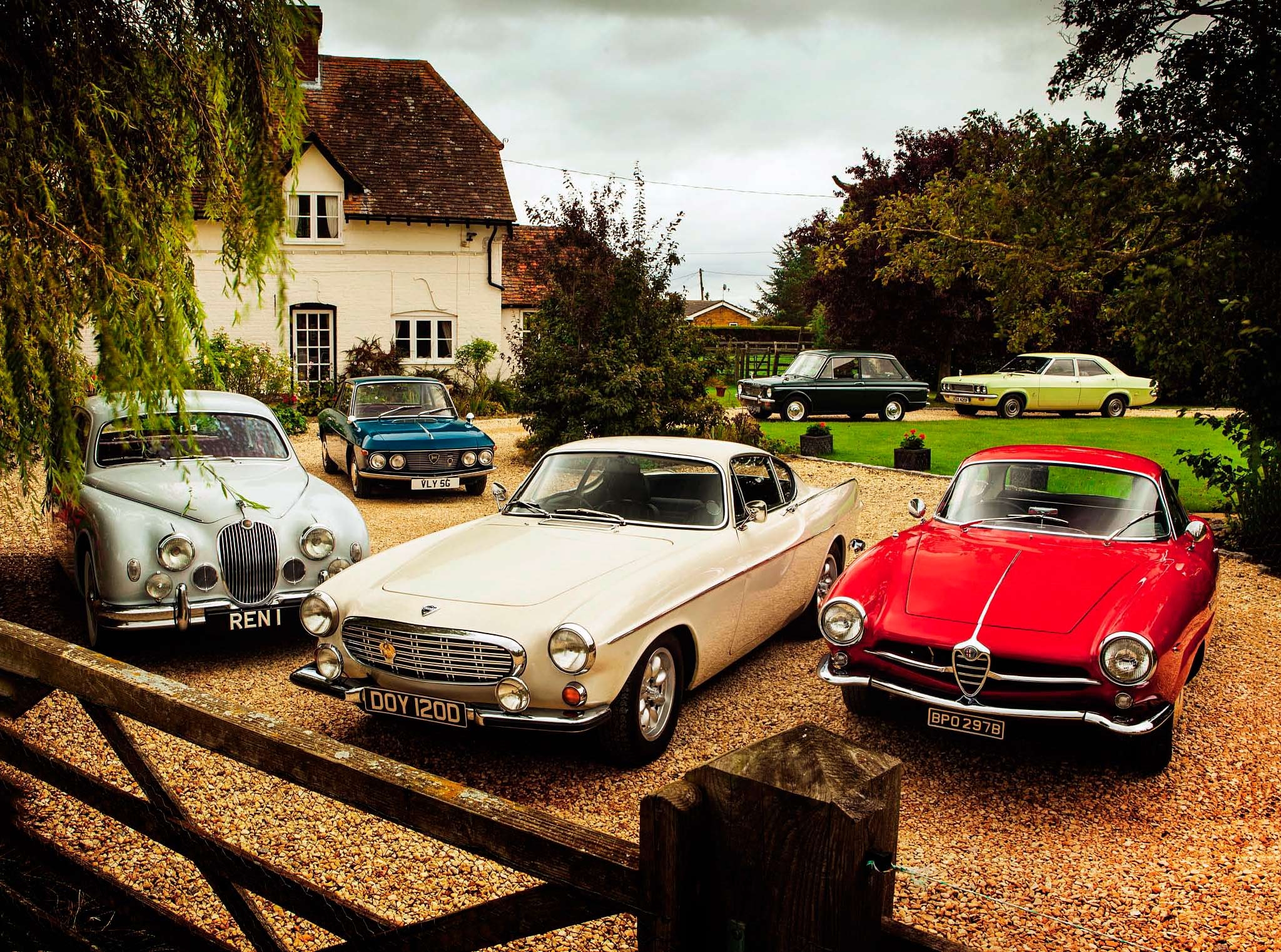
Remembering the motoring heroes of ITC Entertainment’s finest shows. The real stars of ITC. From The Saint to Man in a Suitcase, starring: Jaguar Mark 1 2.4, Volvo 1800, Lancia Fulvia, Alfa-Romeo Giulia SS, Hilman Super Imp and Vauxhall Victor FD. Stars small screen. “Lights… camera… action!” Director of photography Andrew Roberts gathers his favourite automotive leading men and cameos from ITC’s cult TV series. Photography Tony Baker.
Other ITC greats, l-r: Roger Moore’s The Persuaders Aston (plus Tony Curtis’ Dino, far right); Jason King (Peter Wyngarde) with Department S Bentley S2; Prisoner Patrick McGoohan in Moke; Return of the Saint with Ian Ogilvy’s XJ-S.

It’s a seemingly innocent country house somewhere in Oxfordshire, but one that could be hiding any combination of sinister villainy. They may be swarthy and fez-wearing (George Pastell, Paul Stassino), mid-European and sneaky (Vladek Sheybal) or Oriental and generally scowling (Burt Kwouk) – but whatever costume was assigned to them by Elstree Studios, they were never a match for Simon Templar or any other ITC hero.
The Incorporated Television Company was the British firm that for nearly 20 years specialised in making one-hour shows celebrating international men of mystery. The archetypical ITC lead would be a square-jawed type who would undertake virtually any job, in any location, as long as it involved meeting a female guest star who favoured heavy mascara.
Hyper-critical viewers may have noticed how the same bit-part players, wearing the same suits, would appear from week to week, or how ‘overseas location’ footage was either driving on the wrong side of the road in Hertfordshire (foreign) or some palm trees in a discreet corner of the studio car park (Commonwealth). But when ITC’s version of The Saint was first screened in October 1962, it set the template for much that was great in British television – an impossibly suave figure who frequented mocked-up casinos, generally lived a life of low-rent glamour and drove a most splendid motor car.
These machines are a potent reminder of a lost world of heroes who would continue to chain-smoke even as they were being beaten senseless, and when with polish, experience and verve, the studio car park really could be transformed into a place of ‘international glamour’. In the immortal words of ITC supremo Lew Grade: “All of my programmes are great. Some of them are bad, but they’re all great!”
Volvo 1800S THE SAINT, 1962-’1969
As the story goes, Jaguar’s refusal to supply an E-type was famously Volvo’s gain; within a week of ITC’s request, a London dealer had delivered a Jensen-built P1800, 71 DXC, for use in the first episode of The Saint. ITC was also provided with a mock-up for those all-important interior shots (also used as the cabin of the DB5 in Goldfinger). Clever use of post-production dubbing added an even more thrilling exhaust note.
In the late ’50s, Volvo was seeking to enter the sports car market and Helmer Petterson, who had styled the PV444, convinced company chief Gunnar Engellauth that the new car should be penned in Italy. The resulting P1800 sported Frua coachwork on a short-wheelbase version of the Amazon floorpan, powered by a new 100bhp, 1.8-litre engine. Volvo’s lack of factory space meant that early P1800s (1960-’1963) were built at the Jensen plant in West Bromwich.
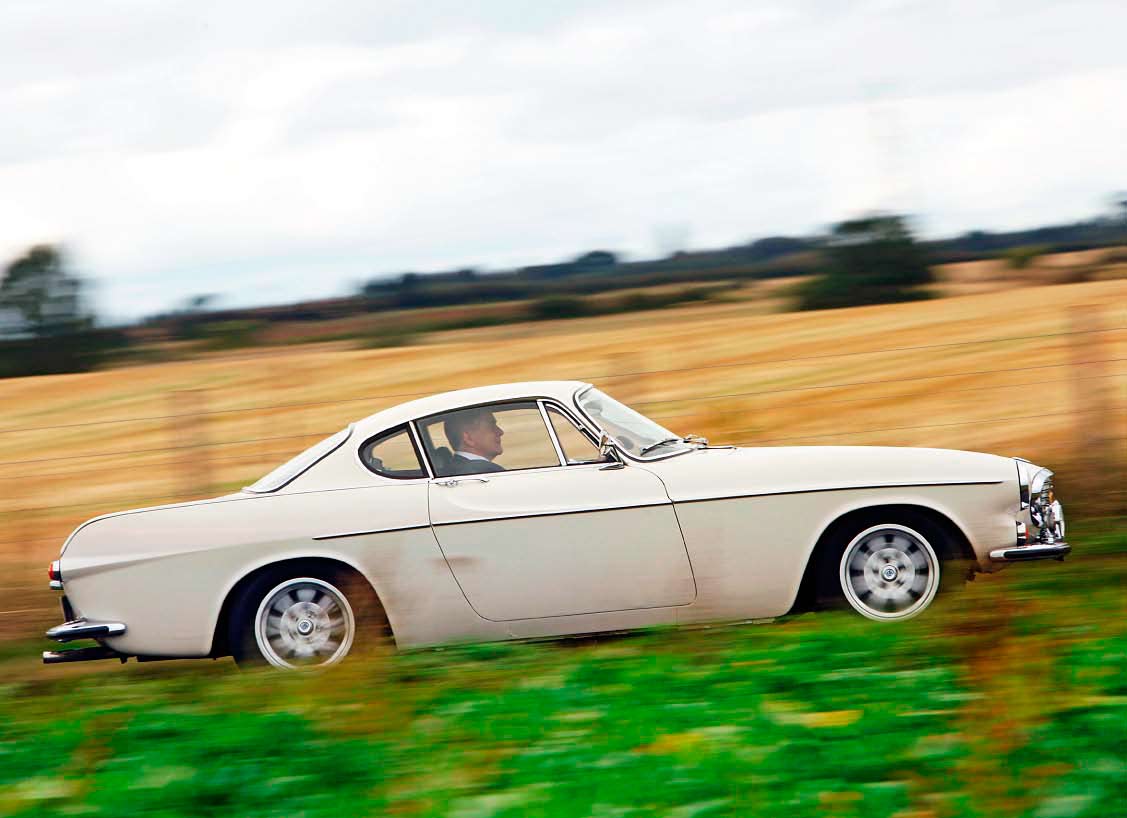
Volvo 1800S road test
By 1963, The Saint (and, off-screen, Roger Moore) was driving the Swedish-built 77 GYL, but for ’65 a radical change was effected in The Case of the Frightened Inn-Keeper: international rotters blew up Templar’s car. Fortunately, he’d taken delivery of a new 1800S (‘S’ for Sweden) by the closing credits and by ’1966 the car had gained some stylish eight-spoke alloys. For ’1967, Simon Templar drove a facelifted Volvo, with a second example being provided for Moore’s own use.
When the final episode, The World Beater, went out in February 1969, ITC had made 118 shows aired in more than 80 countries, achieving sales of £350m-plus thanks to Moore’s eyebrowraising heroics and his Volvo. An 1800S offers looks, practicality and a sense of glamour, but it will be forever associated with defending the free world and, in a moment of TV gold, ridding Wales of mutant killer ants: The House at Dragon’s Rock is essential viewing.
Thanks to Volvo EC: www.volvoenthusiastsclub.co.uk

From top: sportiness and sophistication, perfect for Simon Templar; Moore drove an 1800 off-screen; later car got Minilites; stylish cabin; sturdy ‘four’
Gordon Hunter
Though “slightly too young” to recall The Saint in its heyday, Hunter remains both a devotee and a renowned expert on the 1800 series. He regards the Swedish-built cars as much better made than the early Jensen models – “Volvo made its international name on quality” – and reckons that the 1800’s TV fame introduced its virtues to potential buyers worldwide.
TECHNICAL DATA FILE VOLVO 1800S
Sold/number built 1963-’1969/23,993
Engine ohv 1780cc ‘four’; 108bhp @ 5600rpm; 103lb ft @ 3800rpm
Transmission four-speed manual, overdrive, RWD
Suspension wishbones, coils, telescopic dampers, with rear Panhard rod
Steering cam and roller
Brakes disc/drum
0-60mph 13.2 secs
Top speed 104mph
Mpg 24
Price new £1836 12s 9d
Price now £15,000
Lancia Fulvia Coupé DEPARTMENTS, 1969-’1970
When a case proves too baffling for the minds of Interpol, they turn to the talents of an American in a brown suit, a suave African diplomat, a lady in a mini-skirt and a fop in velvet pantaloons – Department S. One of ITC’s most enjoyable series benefited from some imaginative plot lines, a theme tune almost as groovy as Man in a Suitcase, plus the magnificence that is Peter Wyngarde as Jason King. Naturally, it takes a special car to distract from King’s Bentley S2 saloon by James Young, but the Fulvia Coupé used by computer ace Annabelle Hurst just about manages it. In the sixth episode, The Man in The Elegant Room, the Lancia is even used to monitor a red E-type roadster.
The Fulvia saloon was launched in 1963, only the second Lancia with front-wheel drive and powered by a narrow-angle 1091cc V4. This did not result in blistering performance, but the following year came a 71bhp twin-carb option and in 1965 Lancia unveiled the Fulvia Coupé, designed by Pietro Castagnero. By then the Berlina’s engine had been enlarged to 1216cc and in 1967 the base unit was 1298cc.
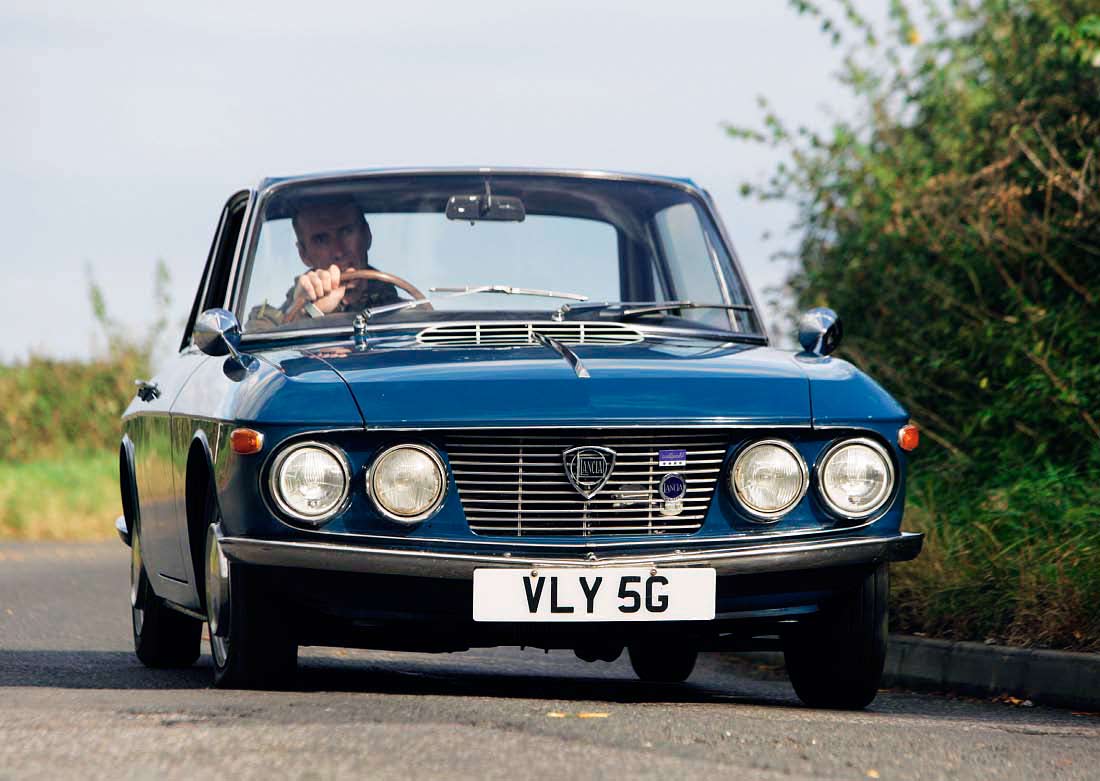
Lancia Fulvia road test
In ’1968, Motor described the Coupé as a classic and to see a rare survivor is to confirm the accuracy of this opinion. It is a tourer built to convey a small family with speed, verve and aplomb, to the musical accompaniment of the V4 – a car that surpasses even King in sheer elegance.
To the average Department S viewer, settling down to a supper of fish fingers in his Wimpeybuilt semi, the idea of an Italian 2+2 with aluminium doors, bonnet and boot was impossibly glamorous beside his five-year-old Cortina. The Lancia also helped to distract from the fact that most of the exotic locations were courtesy of the World Background Film Library.
Thanks to ECC: www.europeanclassiccars.co.uk
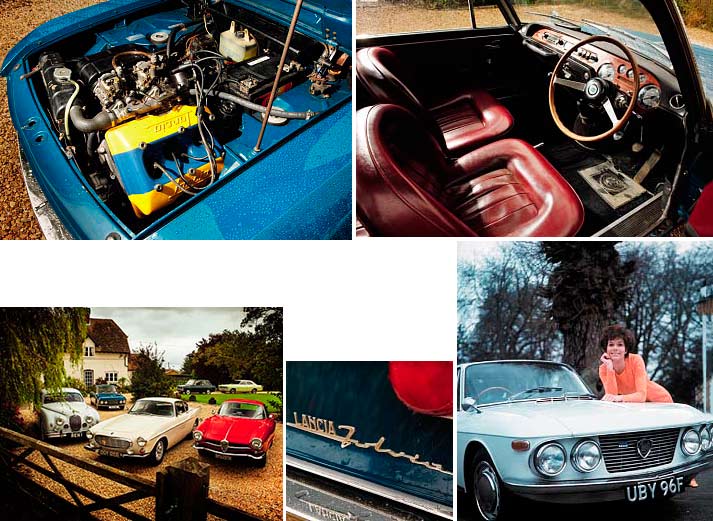
David Honeybun
The owner of European Classic Cars was influenced by his first sighting of a Fulvia Coupé: “I was at college and it made such an impression on me.” He has owned this Coupé since 1986 and regards the Fulvia as: “A total classic. The Series 1 was lighter on the controls than the Series 2, and it is just a wonderful car under all circumstances.”
TECHNICAL DATA FILE LANCIA FULVIA COUPÉ
Sold/number built 1964-’1976/134,035
Engine sohc 1298cc V4; 87bhp @ 6000rpm; 84lb ft @ 4500rpm
Transmission four-speed manual, FWD Suspension: front independent, by wishbones, transverse leaf rear dead axle, semi-elliptics, Panhard rod; anti-roll bar f/r
Steering worm and roller
Brakes discs
0-60mph 11.9 secs
Top speed 103mph
Mpg 27
Price new £1661 18s 4d
Price now £8000
Alfa Romeo Giulia SS THE CHAMPIONS, 1967
This is the everyday story of three secret agents – Craig Stirling (US lead Stuart Damon), the lovely Sharron Macready (Alexandra Bastedo) and Richard Barrett (William Gaunt, aka ‘The Other One’) – with ‘super powers’. In the gripping pilot the trio, all wearing their best black rollnecks, crash their Airfix plane in ‘Tibet’, only to be nursed back to health by a mystic. He bestows upon them the strength to hurl papiermâché rocks at short-sighted villains; low-grade telepathy; even lower-grade mind control; plus the ever-useful ability to flick cups into a bin.
The car most associated with The Champions is Barrett’s white ’1963 Giulia 1600 Sprint Speciale, the car used by Alfa Romeo to spearhead its ’60s PR campaigns. To British and American audiences, any Alfa would have been exotic and the appeal of the Giulia SS is best encapsulated by an early UK-market advert: ‘For the man who has everything, here is the car to keep him company… Expensive? Naturally! What else would you expect a hand-built Alfa to be?’
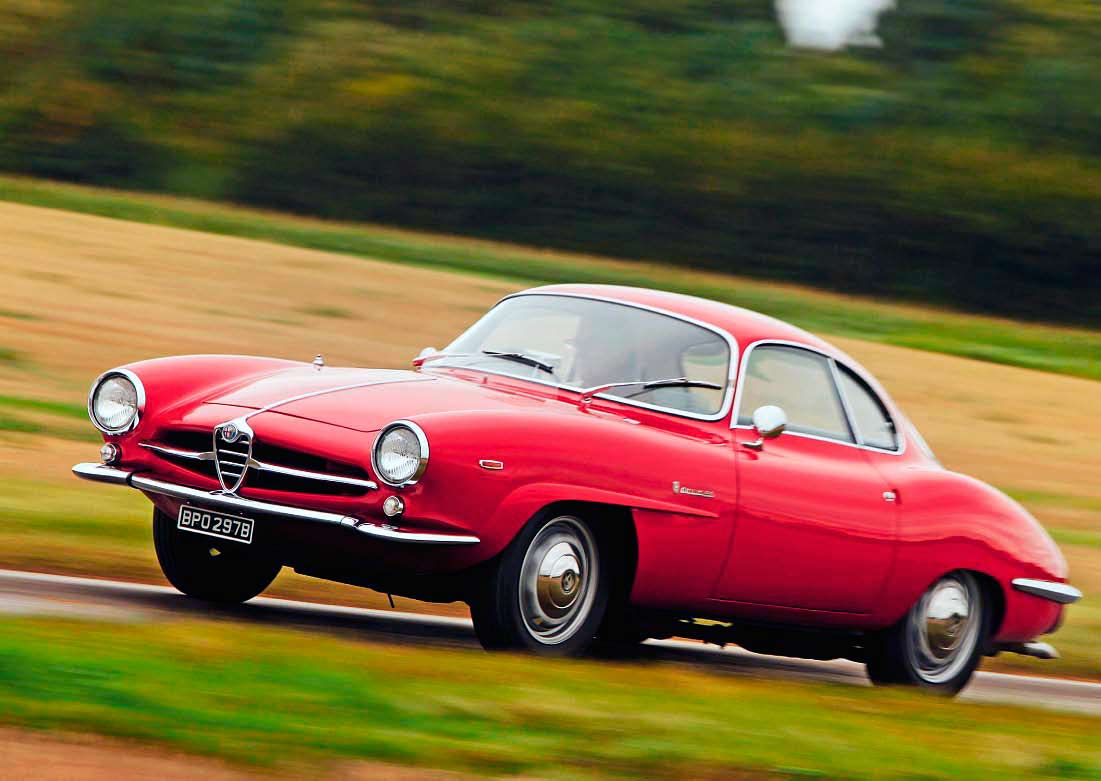
Alfa-Romeo Giulia SS road test
And expensive indeed it was, but what is mere l.s.d. when faced with an SS powered by that glorious engine with twin Webers, lightweight Bertone body and a five-speed ’box? The coachwork may not have been entirely suited to men of mystery with a larger-than-average stature, but the drag coefficient was a mere 0.28 and the Giulia SS was far more exclusive than an E-type, with just 1400 made between 1963 and 1965.
The SS in The Champions was previously seen in The Saint because it was owned by the ITC producer Monty Berman. The show may feature an Outback skyline with wrinkles, European roads with Give Way signs and supporting actors with the thespian verve of a Vauxhall Viva, but this is of little import when Barrett is at the wheel of his Sprint Speciale. Or when he utters those famous words : “ Craig… we’re… different!”
Thanks to ECC: Alfa-Romeo UK
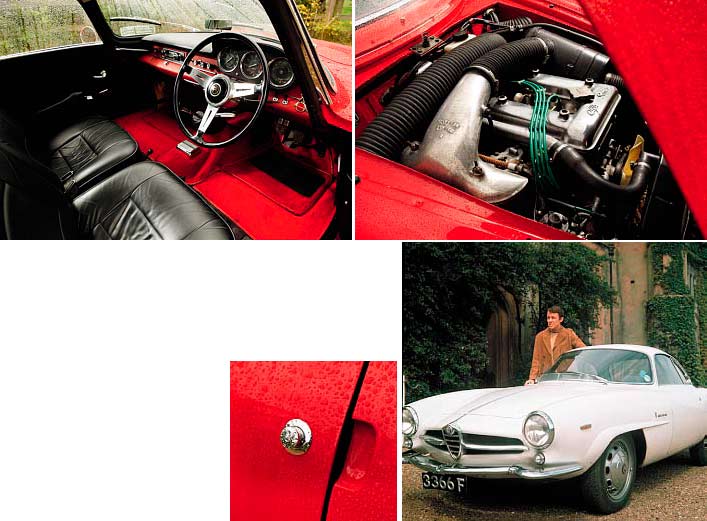
From top: Barrett’s Alfa was an unusual choice; SS still has capacity to wow today; stunning Bertone detailing; sporty interior; willing 1570cc twin-cam.
Glyn Giusti
Giusti first tried to buy an SS when he was 18: “I was about to hand over £180 to a London dealer when a friend noticed that one side was totally rotten!” This example was acquired five years ago and is owned by his wife. “I believe that a classic car is there to be enjoyed,” says Giusti. To that end, the SS is taken on holiday: “And just driven the way it should be.”
TECHNICAL DATA FILE ALFA ROMEO GIULIA SS
Sold/number built 1963-’1966/1400
Engine dohc 1570cc ‘four’; 112bhp @ 6500rpm; 98lb ft @ 4200rpm
Transmission five-speed manual, RWD
Suspension independent front wishbones rear trailing arms; coils, anti-roll bar f/r
Steering rack and pinion
Brakes disc/drum
0-60mph 12 secs
Top speed 124mph
Mpg 23
Price new £2394 1s 3d
Price now £50,000+
Jaguar 2.4 MOSTITC SHOWS
When ITC was planning an elaborate stunt for The Baron (a square-jawed, Jensen-driving American antiques dealer in London battling with sunshade-wearing villainy), it was not interested in the fact that Jaguar’s management had decided to broaden the model line-up in the early ’50s. Nor was it concerned that ‘Project Utah’ spawned the 2.4, star of Earls Court in ’1955 and Jaguar’s first monocoque. Or that this model founded a 15-year dynasty of compact saloons. No, what it wanted was to drive a car off a cliff.
The Baron fans saw a white Mk1 out of control on Ivinghoe Beacon in the Chilterns, cutting to a second car careering down Zig Zag Road on Box Hill, Surrey. The sequence then moved to Betchworth Quarry, near Dorking, an automatic camera was placed in the Jag, and some spectacular footage was retrieved from the wreck.
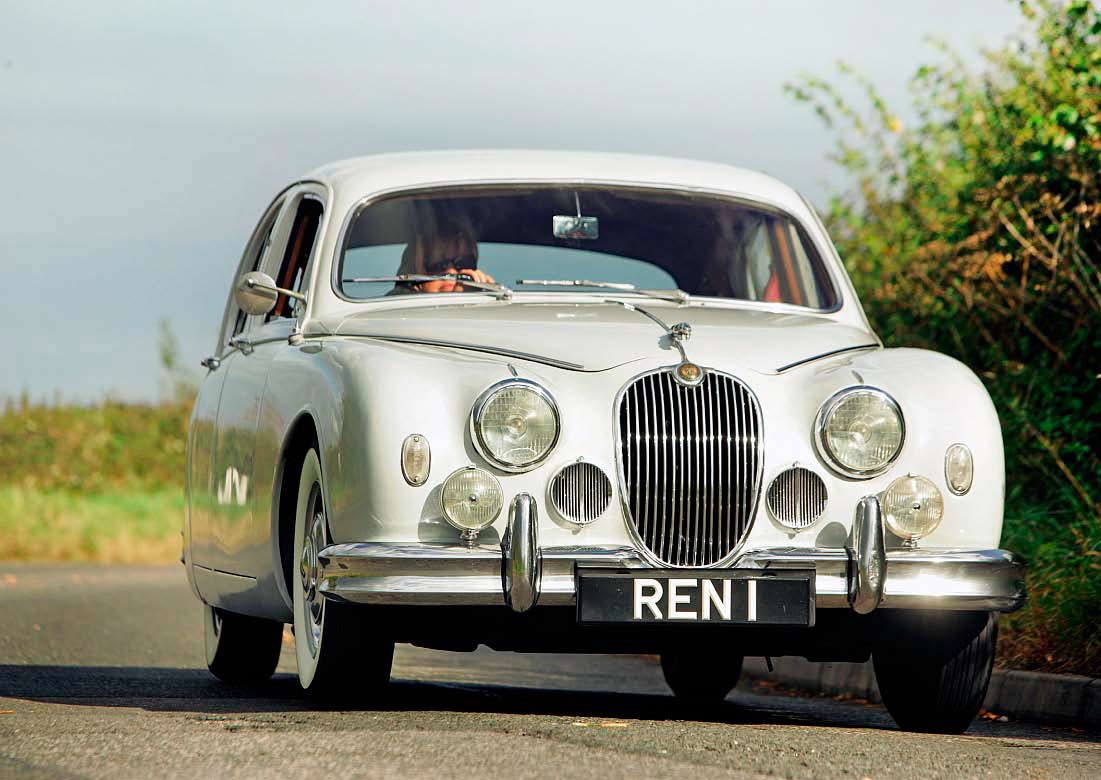
Jaguar Mk1 2.4 road test
It was an expensive scene, so no matter what car was chasing an ITC hero for the next decade it often transformed into a white Mk1. Additional scenes were later shot so the Mk1 could turn into a Mk2, an S-type or a Daimler before switching back and crashing, usually just prior to a close-up of George Pastell in regulation fez.
The 2.4 is such an enjoyable car that it is hard to watch The Saint/The Baron/Randall & Hopkirk/ The Persuaders/Jason King/The Adventurer (ITC got good value from its stunt footage) without mixed feelings. By European standards, a Mk1 is by no means compact – it’s larger than a Zodiac or a Cresta – but it is much smaller than a MkVII, with an elegance all of its own. And pressing the starter releases the finest sound of 1950s Britain this side of Lonnie Donegan’s Cumberland Gap. If agents of an enemy power had to descend a cliff in a hurry, they could hardly have chosen a more soignée form of transport.
Thanks to Jaguar DC: www.jaguardriver.co.uk
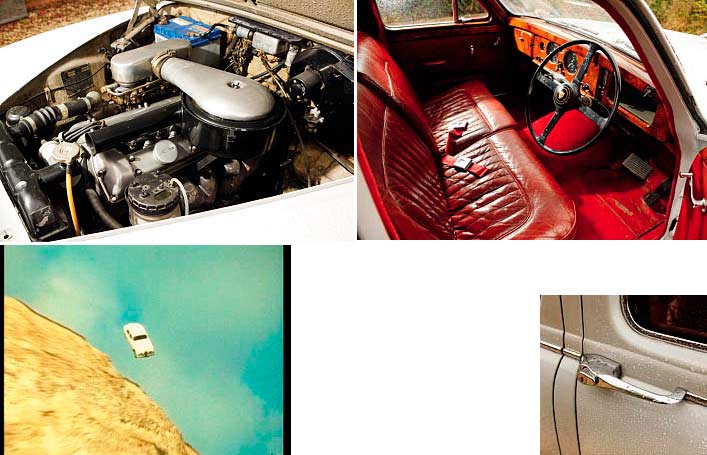
Looking at this lovely Mk1, it’s hard to believe that ITC was willing to chuck one off a cliff (inset). Below: smallest XK unit still has 112bhp; olde-worlde charm.
Phil Walters
Jaguar expert Walters came by this 1958 2.4 – “a piece of Coventry motoring” – in 2005. He has found that, although the teardrop shape is “purely for effect”, the Mk1 is as adept for everyday motoring as the Mk2. Walters also believes that the auto transmission is superior to the Moss manual: “It’s so smooth and makes the Mk1 more modern-feeling to drive”.
TECHNICAL DATA FILE JAGUAR MK1 2.4 / Mark 1
Sold/number built 1955-’1959/19,400
Engine dohc 2483cc ‘six’; 112bhp @ 5750rpm; 140lb ft @ 2000rpm
Transmission three-speed auto, RWD
Suspension: front independent by semi-trailing arms, coils rear trailing links, radius arms, semi-elliptics; telescopics f/r
Steering recirculating ball
Brakes disc/drum
0-60mph 14.4 secs
Top speed 101mph
Mpg 24
Price new £1298
Price now £10,000+
Vauxhall Victor FD RANDALL AND HOPKIRK (DECEASED), 1969-’1970
The pair of private eyes with a difference… one of them is dead! Yes, Marty Hopkirk is run over in the opening credits by a Humber, but returns as a white-suited and toupée-topped ghost to assist partner Jeff Randall. Randall and Hopkirk (Deceased) was the show that had it all: Edwin Astley theme tune, Annette André in some very small mini-skirts and glorious predictability.
Every week, Randall would be attacked by villains who obviously objected to his taste for hideous tan-leather jackets, or the fact that actor Mike Pratt had co-written the Tommy Steele song Little White Bull. Each week, Jeff would enquire why Marty could not remain dead like other ghosts. And each week, Jeff would grimly drive a white Vauxhall Victor FD 2000 as deadly back-projection attempted to overtake him.
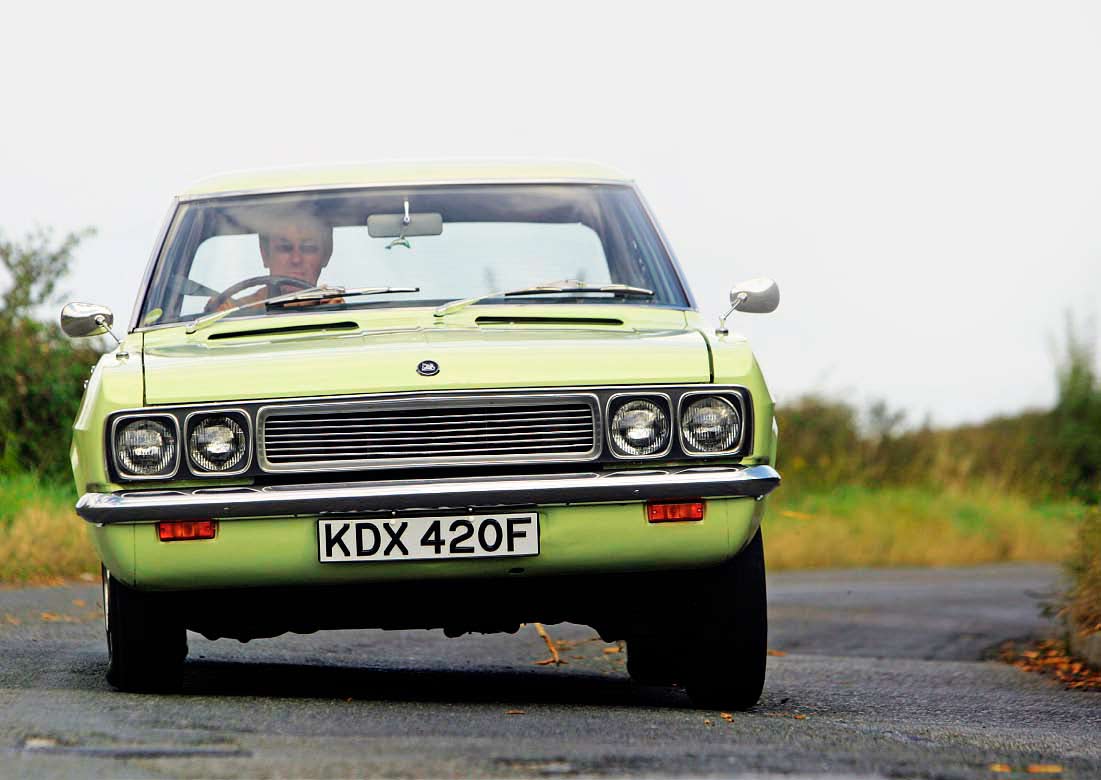
Vauxhall Victor FD 2000 road test
If the series endures to this day, it is largely due to the chemistry between the leads and their mode of transport. When Vauxhall loaned ITC a press car in May 1968, they ensured its place in small-screen history – not that the fourth incarnation of the Victor lacked interest in its own right. When the FD was launched in late ’1967, it was acclaimed by The Sunday Times as ‘British Car of the Year’, and it was the UK’s first massproduced car with a belt-driven overhead-cam engine. The entry-level model could be had with a column-change 1.6, but an ITC hero obviously merited the Victor 2000 with four on the floor.
Survivors of the FD are rare – Vauxhalls of this era do suffer from tinworm – and our test car is a wonderful reminder of the naffness of late-’60s Britain. Every detail of the 2000, from mockwood dashboard to Ambla upholstery, is quite perfect in its way. When this is combined with the FD’s sharp styling and comfortable ride, it is truly a car fit for an ITC leading man… tan leather jacket notwithstanding.
Thanks to VFDR: www.vauxhallfdregister.co.uk

Inset, top: Kenneth Cope (Hopkirk) and Mike Pratt (Randall) woo the ladies with their Victor. From main: FD still looks sharp; vinyl paradise; ohc ‘four’.
Chris Parsons
Parsons was first attracted to the Victor FD “by its looks” back in 1990. He bought his splendid example five years later, although in 1999 it suffered from “an argument with a lorry”. The 2000 was laid up for the next 11 years, during which time Parsons bought several more Victors, before it was revived with new paintwork in 2011.
TECHNICAL DATA FILE VAUXHALL VICTOR FD 2000
Sold/no built 1967-’1972/198,085 (all FDs)
Engine sohc 1975cc ‘four’; 88bhp @ 5500rpm; 109lb ft @ 3000rpm
Transmission four-speed manual, RWD
Suspension: front independent by wishbones rear live axle, trailing arms, Panhard rod; coils, telescopics f/r
Steering rack and pinion
Brakes disc/drum
0-60mph 15 secs
Top speed 95mph
Mpg 24
Price new £910 1s 6d
Price now £3500
Hillman Imp MAN IN A SUITCASE, 1966-’1967
Man in a Suitcase boasted arguably the finest theme tune in the history of UK television and starred the intense American method actor Richard Bradford as an embittered, chainsmoking former CIA agent in an ambitious attempt at a British Marlowe set in a world of Fine Fare supermarkets and mundane cars. Being an ITC show, it had the obligatory ‘Iron Curtain’ episode – with a home-made border crossing in the midst of Black Park – but in the main this was a downbeat and surprisingly violent series.
Bradford drove a succession of Imps, one of them a 1965 Orchid Green ex-Rootes Group PR Rally Imp fitted with a 65bhp 998cc engine, but through 1966 and ’1967 he also piloted a brace of Imp De Luxes and a Singer Chamois along the mean streets of Pinewood Studios. In one of the best episodes, The Sitting Pigeon, great screen villain George Sewell refers to the Imp as “a heap of junk”, causing our hero to narrow his eyes and smoke even more furiously.

Hilman Super Imp road test
It’s easy to see why ex-agent McGill was so attached to one of Britain’s most underrated cars. The Super badge on this Imp denotes a carpeted floor and twin-tone horns, but the main appeal is one of the sweetest engines of any small British car, plus smoothly pseudo-American styling and any number of well-crafted features from the opening rear screen to the ergonomic instrument panel. There was also more than enough space for McGill and a trio of ITC’s finest heavies, plus superb road manners. The Imp’s 13-year production run was ended in 1976, leaving behind memories of great lost opportunities – and the sight of an isolated figure driving his green compact through a misty London morning towards another assignment in one of ITC’s best-ever programmes.
Thanks to The Imp Club: www.theimpclub.co.uk
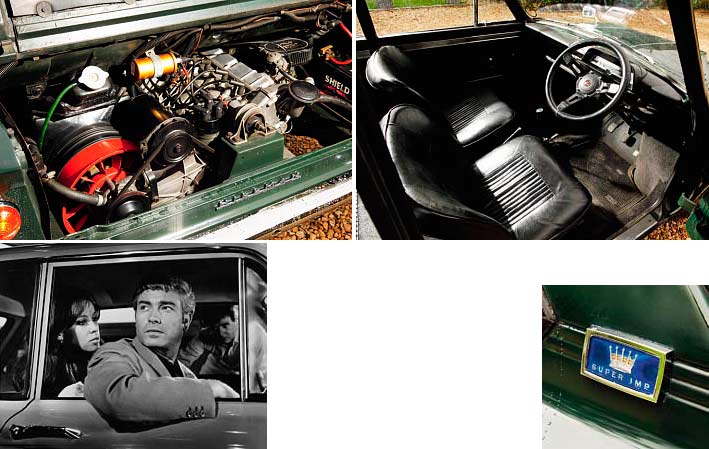
From top: Imp is a sparkling performer; steely star Bradford; ‘Super’ spec brings extra trim; Climaxderived unit; rear engine means a spacious cabin.
Brian Sparks
Sparks has been an Imp man for nearly all of his driving life and, although he is very modest about his Super model – “it is by no means concours” – he derives great pleasure from using it. “By 1966,” he says, “Rootes had solved many of the early problems and it was a shame that the Imp’s image could not be recovered because it is one of Britain’s great cars.”
TECHNICAL DATA FILE HILLMAN SUPER IMP
Sold/no built 1963-’76/440,032 (all Imps)
Engine sohc 845cc ‘four’; 39bhp @ 5000rpm; 52lb ft @ 2800rpm
Transmission four-speed manual, RWD
Suspension independent, by swing-axles, coil springs, telescopic dampers
Steering rack and pinion
Brakes drums
0-60mph 22 secs
Top speed 78mph
Mpg 35.5
Price new £565 17s 1d
Price now £2000





